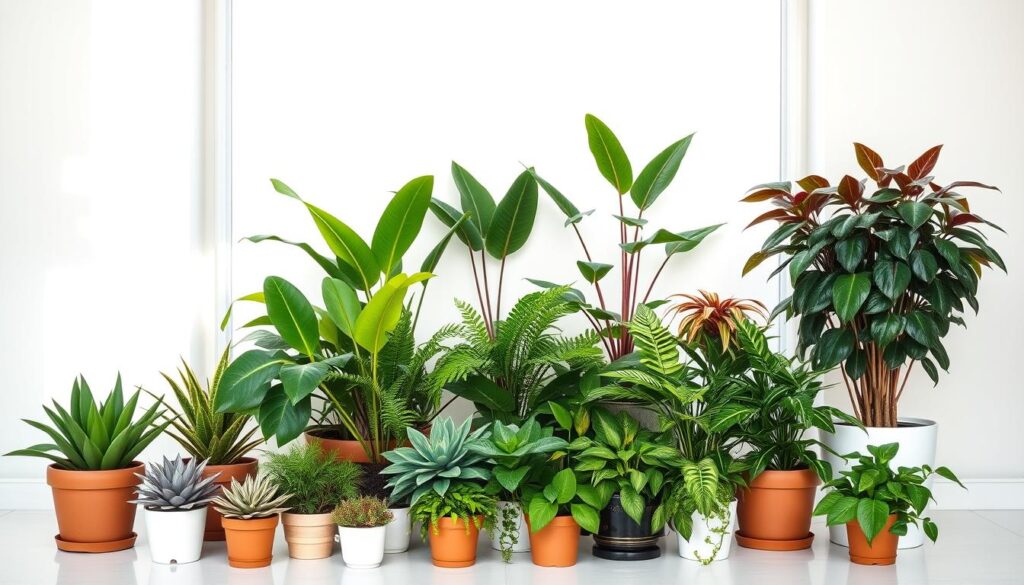Indoor plants do more than just look pretty; they are key in indoor gardening. This guide gives you all you need on plant care, the newest trends, and the good stuff about having plants at home. Having plants around makes your space look good and boosts your well-being.

Seek App
We’ll go over easy plants to start with and some unique ones. This guide has everything for a great indoor gardening journey.
Anúncios
Understanding Indoor Plants
Indoor plants need environments similar to where they naturally grow. Different plants need different care. For example, tropical plants like warm and humid places, but succulents like it dry. Knowing what each plant needs helps keep them healthy and good-looking.

Anúncios
Starting with indoor gardening means looking at light, water, and temperature. These factors really affect how well your plants do. Every plant has its own likes and dislikes, so learning about them is key. This helps your indoor plants do well and make your home more beautiful.
Best Types of Indoor Plants to Consider
If you’re new to indoor gardening, choosing the right plants is key. Great houseplants make your space look beautiful with little work. They’re perfect for beginners or busy folks.
Popular Houseplants for Beginners
Some houseplants are great for beginners because they’re tough and easy to take care of. Top picks include:
- Pothos: Known for its trailing vines and flexible light requirements.
- Snake Plant: Hardy and tolerant of neglect, it thrives in various conditions.
- Spider Plant: Adaptable and produces baby plants, making it enjoyable for new plant parents.
These plants don’t need much attention, making them great for new gardeners.
Low-Maintenance Options for Busy Lifestyles
Want plants that don’t need much time? Go for low-maintenance options. Good choices include:
- ZZ Plant: Tolerant of low light and infrequent watering, it suits a busy schedule.
- Succulents: These hardy houseplants store water in their leaves, allowing for long periods between watering.
These plants help keep up an indoor garden without eating into your schedule.
Essential Care Tips for Indoor Plants
Caring for indoor plants means knowing their needs for water, food, air, and warmth. By using some key tips, you can make sure your plants do well inside your home.
Watering Requirements: When and How
Watering right keeps indoor plants healthy. It’s important to check the soil’s moisture before watering. Only water when the top 1 to 2 inches of soil feel dry.
When watering, use a gentle flow to soak the soil without wetting the leaves. Too much water can harm your plants, so watch their water needs closely.
Fertilizing Indoor Plants: What You Need to Know
Feeding your plants is key, especially in spring and summer. Use balanced fertilizers to boost your plants’ health. Always stick to the recommended amount to avoid damaging the roots with too much fertilizer.
This careful feeding helps your plants grow strong.
Humidity and Temperature Considerations
Every plant likes different levels of humidity. Tropical plants love moisture, but succulents prefer it dry. Keep plants away from air vents to avoid stress.
Stable temperatures are important for plant health. Quick changes can hurt them. Using humidifiers or placing plants together can keep the humidity just right.
Indoor Plants Care: Common Challenges
Taking care of indoor plants comes with its ups and downs. One major mistake people make is overwatering them, which can harm their roots badly. By spotting the early signs of too much water, you can keep your plants safe. It’s also important to watch out for pests and diseases in houseplants. Being aware helps a lot in keeping your plants healthy and happy.
Overwatering and Its Consequences
Overwatering is a common mistake among plant lovers, and it can kill plants by choking their roots. You can tell a plant is overwatered if it has:
- Yellowing leaves
- Mushy stems
- Foul odor from the soil
Make sure the top layer of soil is dry before watering again. This simple step can keep your plants thriving.
Dealing with Plant Pests and Diseases
Bugs like aphids and spider mites are big threats to indoor plants. Checking your plants often can help spot problems early on. Getting rid of pests usually means:
- Using insecticidal soap
- Implementing environmental controls
- Keeping plants well spaced for air circulation
Staying ahead of issues is key to keeping your plants free of common diseases.
Recognizing Signs of Stress in Plants
Knowing what to look for can help you take quick action when your plants are stressed. Stress signals include:
- Wilting leaves
- Stunted growth
- Discoloration of leaves
Fast action on watering and dealing with pests can help troubled plants bounce back.
Trendy Indoor Plants to Watch in 2023
The world of houseplants is always changing. In 2023, we’re seeing new plant trends and old favorites making a comeback. People are adding bright, lively trendy houseplants 2023 to their homes. These plants are more than just decorations; they spark conversations. Whether you’re a serious collector or just enjoy a few plants, there’s a wide range of popular and unique indoor plants waiting for you.
Must-Have Houseplants for Your Collection
The fiddle-leaf fig is a must-have this year. Its big, shiny leaves can make any space look elegant. Another favorite is the monstera. Its unique split leaves attract people who love exotic houseplants. These plants add a tropical vibe to your home.
Colocasia and Other Unique Varieties
Colocasia plants are becoming very popular because of their big, interesting leaves. Taking care of them, or colocasia care, is a hot topic. People want to know how to keep them looking beautiful. Their tropical style can make any room look better. This year, try adding some Colocasia to your plant collection for a new look.
DIY Projects for Indoor Plant Lovers
Indoor gardening lets plant lovers explore their creative side with DIY projects. Two exciting options are making an indoor living wall and creating a self-sustaining terrarium. Both add a special touch to your space and improve the indoor air.
Creating a Stunning Indoor Living Wall
An indoor living wall can transform any room into a stunning space. It uses wall space to grow a variety of plants vertically. To make sure it grows well, keep these tips in mind:
- Choose appropriate plants with similar light and water needs.
- Plan the layout for visual appeal and even coverage.
- Ensure adequate lighting for all plants, either natural or artificial.
With good planning, your indoor living wall can become a green haven inside your home.
Building a Self-Sustaining Terrarium
Creating a terrarium is a fun way to add greenery to your space. This project makes a closed ecosystem for plants, which helps reduce the need for watering. Follow these steps:
- Select a glass container – the size depends on the plants chosen.
- Layer the bottom with drainage materials like pebbles or charcoal.
- Add a suitable growing medium and arrange your plants.
Not only does a terrarium look great, but it’s also low-maintenance. It’s perfect for those who love indoor plants.
Creative Ways to Display Indoor Plants
A well-thought-out plant shelf doesn’t just show off your indoor plants. It also makes your space look better. Try mixing plants of different heights and types. This makes for a more lively view. Using shelves at various heights can help each plant get the right amount of light. This helps them grow strong and healthy.
Plant Shelf Ideas for Your Home
Shelves offer many clever ways to arrange your plants. A tiered shelving unit works great for showcasing different plants. It creates a vibrant look. Here are a few ideas for displaying your plants:
- Incorporate floating shelves to add views of your plants without using floor space, embracing vertical plant gardening.
- Use decorative boxes or baskets on shelves for a stylish touch while maintaining functionality.
- Highlight colors and textures by mixing pots; consider ceramic, metal, or woven materials.
Utilizing Vertical Spaces with Hanging Plants
Hanging plants are a great choice for small spaces. They help keep your floors clear. You can use macramé hangers or modern pots to highlight your plants. They also add interesting textures to your decor. Here are some ways to display your hanging plants:
- Install ceiling hooks or wall-mounted brackets for a sleek hanging arrangement.
- Combine various lengths of hanging plant pots to create a dynamic and layered visual.
- Choose plants that thrive in hanging settings, such as spider plants or pothos, for an impressive effect.
Indoor Plants and Their Health Benefits
Indoor plants are more than just pretty to look at. They improve our surroundings and are good for our health. Having plants around us is great for our well-being.
How Plants Improve Air Quality
Indoor plants help clean the air, taking out harmful toxins. Peace lilies and snake plants are really good at this. They can lower allergy symptoms and make breathing easier, which significantly enhances our daily life.
Psychological Benefits of Indoor Gardening
Gardening inside has great mental health perks. It lowers stress and makes us happier. Watching plants grow boosts creativity and gives us a sense of success.
This hobby makes our living areas more calming. It’s not just good for the plants but also for us.
Choosing the Right Pots for Your Indoor Plants
Finding the right pot is key for your indoor plant’s health and look. You need to think about the pot’s size, what it’s made of, and if it drains well. The best pots do more than hold dirt; they help roots grow strong. Also, pots that look good can make your space nicer while meeting your plant’s needs.
Factors to Consider in Pot Selection
Keep these points in mind when picking a pot:
- Size: Pick a pot that fits your plant well. Too small, and the roots won’t have room to grow. Too big, and you might water it too much.
- Material: Each material has its plus points. Terracotta pots let roots breathe, while ceramic pots look pretty.
- Shape: The shape matters too. Some plants like deep pots better, others go for wider ones.
Drainage and Soil Requirements
Good drainage is super important for indoor plants. Use pots with holes to let extra water out. This keeps root rot away, a big problem for indoor plants. Picking the right soil mix helps your plants grow well, too. Choose soil that fits your plant’s needs perfectly, so they can flourish in their pretty pots.
Indoor Plants: Troubleshooting Common Issues
Indoor plants can face many problems that harm their health and looks. It’s key to know why leaves change color or plants grow tall and thin. By figuring out and fixing these issues, your plants can thrive.
Understanding Leaf Discoloration
Leaves changing color can mean a few health problems for plants. Leaves turning yellow might be from too much water or not enough nutrients. This can happen if they don’t get enough light. It’s important to watch your plants closely. Brown edges could mean not enough water or bugs attacking the plant. Checking your plants often helps you catch and solve problems early.
What to Do About Leggy Growth
Plants often grow tall and thin if they’re not getting enough light. If this happens, trimming the plant can help. Cutting back long stems helps the plant grow back fuller and healthier. It also helps light reach more of the plant. Moving your plants to places with more light will also help them look better.
Plant Grouping: The Art and Science
Putting houseplants together is not just for looks; it’s about knowing how plants interact and what they need. When you group the right plants, you can make the air more humid and help plants grow. This way, your indoor garden will be lush and healthy.
Perfect Plant Pairings for Healthy Growth
Here are some tips for choosing plants that grow well together:
- Ferns and Peace Lilies: Both love moist air, so they’re great partners.
- Succulents and Cacti: These plants do well in dry places.
- Snake Plants and ZZ Plants: They don’t need much light or water.
Putting these plants together can make your home brighter and your plants happier. Just make sure you give them the right amount of water and light. Then, they won’t fight for what they need.
Avoiding Plant Compatibilities and Conflicts
But, be careful when you’re mixing plants. Don’t put together those that need different things. For instance:
- Tropical plants need a lot of moisture, but succulents don’t.
- Flowering plants might want lots of light, which isn’t good for those that like the shade.
- Don’t put big eaters with plants that barely need to be fed.
To keep your indoor garden healthy, think about which plants get along. This way, you can make a peaceful spot full of life.
Seasonal Care for Indoor Plants
Indoor plants do their best when we change our care to match the seasons. Each season has different needs that we should meet for our plants. For example, in winter, plants grow slower because there is less light and it’s colder.
To help your plants during each season, remember these tips:
- Keep an eye on light levels. Shorter winter days mean plants might need more sunlight.
- Water less in cooler times. Cold weather makes water evaporate slower, so plants don’t need as much.
- Make it more humid for tropical plants in winter. They like it warm and moist.
Spring is when things really start for indoor gardeners. It begins a time of strong growth for lots of plants. So, it’s important to give them more food and adjust the light they get.
Conclusion
We covered a lot about caring for indoor plants. We talked about choosing the right plants and how to take care of them. It’s important to know what each plant needs and to be detailed in caring for them. By doing this, anyone can make their home greener and more lovely.
Let’s remember the key points about indoor plants as we finish. They make our homes look nicer and can even make the air cleaner. Whether you’ve been growing plants for a while or are just starting, being patient and watching your plants carefully are the best ways to keep them healthy.
Keeping up with plant care trends and recognizing common problems will help you solve them faster. Take pleasure in caring for your plants, and see how they make your living space more inviting. Your home can become a beautiful green haven.
FAQ
What are the best low-maintenance indoor plants for beginners?
How often should I water my indoor plants?
What types of indoor plants are known for improving air quality?
What factors should I consider when selecting pots for indoor plants?
How can I create a living wall indoors?
What are common signs that my indoor plant is stressed?
Can I group different types of plants together?
What should I do if my indoor plants experience leggy growth?
How can indoor gardening contribute to mental well-being?
What are some trendy plants to consider in 2023?
Content created with the help of Artificial Intelligence.



